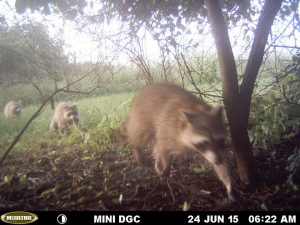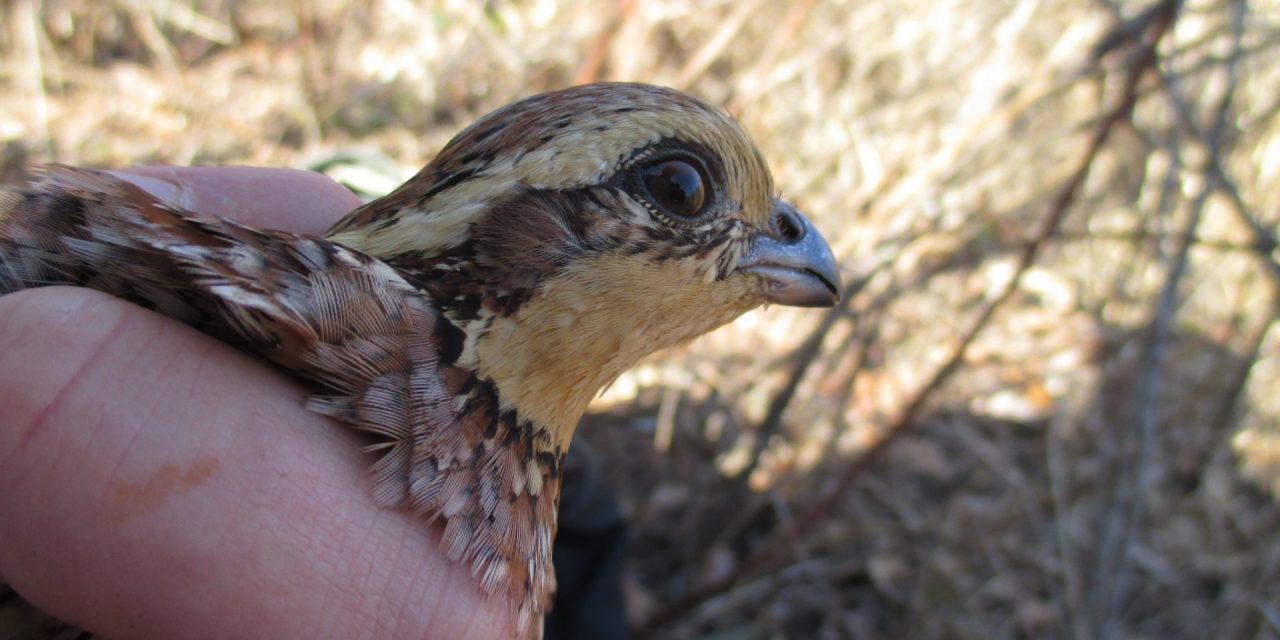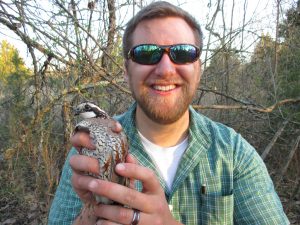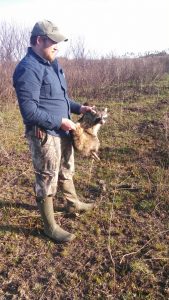The black-and-white image on Jacob McClain’s computer shows two raccoons on a shrubby patch of forest in southwest Missouri. One raccoon is digging while the other has its nose to the ground.

A game camera captured this image of raccoons foraging for food in southwest Missouri. | Arkansas Cooperative Fish and Wildlife Research Unit/Jacob McClain
They’re looking for food, McClain explained while sitting at his workspace in the Arkansas Cooperative Fish and Wildlife Unit, housed in the Department of Biological Sciences at the University of Arkansas. Actually, they were taking the bait in the form of dog food and fish oil that McClain put out to attract the raccoons to an infrared game camera.
McClain, a master’s student in biology at the U of A is relying on these cameras and tracking devices to estimate the abundance, foraging behavior and spatial ecology of medium-sized mammals that prey on the nest and brood of the northern bobwhite quail.
His project is part of a larger, five-year study by the Missouri Department of Conservation on the populations of northern bobwhites on two types of public conservation areas in the state: those that are managed intensively and those that are managed extensively.
The intensive model approach includes creating small, rectangular interspersed patches of grass, cropland, woodlands and bare ground. The extensive model uses prescribed fire and grazing to produce the desired habitat that northern bobwhite prefer.
Missouri wildlife officials spend a lot of money on the intensive management approach with the idea that it will raise the abundance of the northern bobwhite, which has experienced a sharp population decline across the United States in the last five decades.
“The idea of the intensive management model means that within 40 acres you give everything that a quail needs to survive and thrive in,” McClain said. “Missouri is putting a lot of money into these intensively managed areas, specifically for quail. It’s a game species that people still hunt but it is also a species of conservation importance, and that is why I think this study is so interesting.”
Two conservation area managers noticed a few years ago that there are less northern bobwhites in the areas they are managing for the birds than in the areas they aren’t managing for them. They think that the diversity of habitats they are creating in the intensively managed areas is also attracting animals that raid quail nests for eggs and chicks, specifically raccoons and opossums.
That’s where McClain comes in. He is one of a dozen graduate students who perform research in the Arkansas Cooperative Fish and Wildlife Unit, a partnership of the U.S. Geological Survey, the Arkansas Game and Fish Commission, the University of Arkansas and the Wildlife Management Institute.

A game camera captures raccoons in southwest Missouri. | Arkansas Cooperative Fish and Wildlife Research Unit/Jacob McClain
In 2015, McClain was tasked with studying the populations of raccoons and opossums in state-owned conservation areas: Robert E. Talbot (intensively managed) and Stony Point Prairie (extensively managed). This year, he expanded his study to include two additional conservation areas: Wah-Kon-Tah Prairie (extensively managed) and Shawnee Trail (intensively managed). The research is funded by the Missouri Department of Conservation, the U of A and the Arkansas Game and Fish Commission.
The primary goal is to estimate the abundance and density of raccoons and opossums on intensively managed areas and extensively managed areas and compare the two, McClain said. The secondary goal is to study how these predators, specifically raccoons, move through the landscapes.
“The intensively managed areas create a lot of edge habitat that we think the raccoons are using as foraging corridors,” he said. “Rather than having to push through a bunch of brambles and prairie grasses, they are following these hard edges that allow them to forage more efficiently. They can travel a lot easier and not have to worry about encountering a coyote or some other predator. They have lots of escape routes.”
McClain will follow the raccoon movements by trapping and attaching collars that record GPS data. The researchers want to compare both how the predators move through intensive and extensive areas and compare home range sizes in intensive and extensive areas.
“Higher predator abundance means more quail are going to die,” he said. “If the results indicate that we’re ringing the dinner bell for predators to come in and eat quail nests, we probably need to make some changes. Maybe we could take some of these intensively managed areas and manage them more holistically like the extensive approach through the processes of fire and grazing.”







You must be logged in to post a comment.